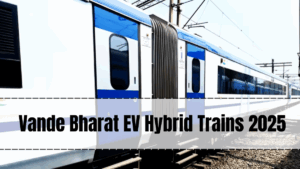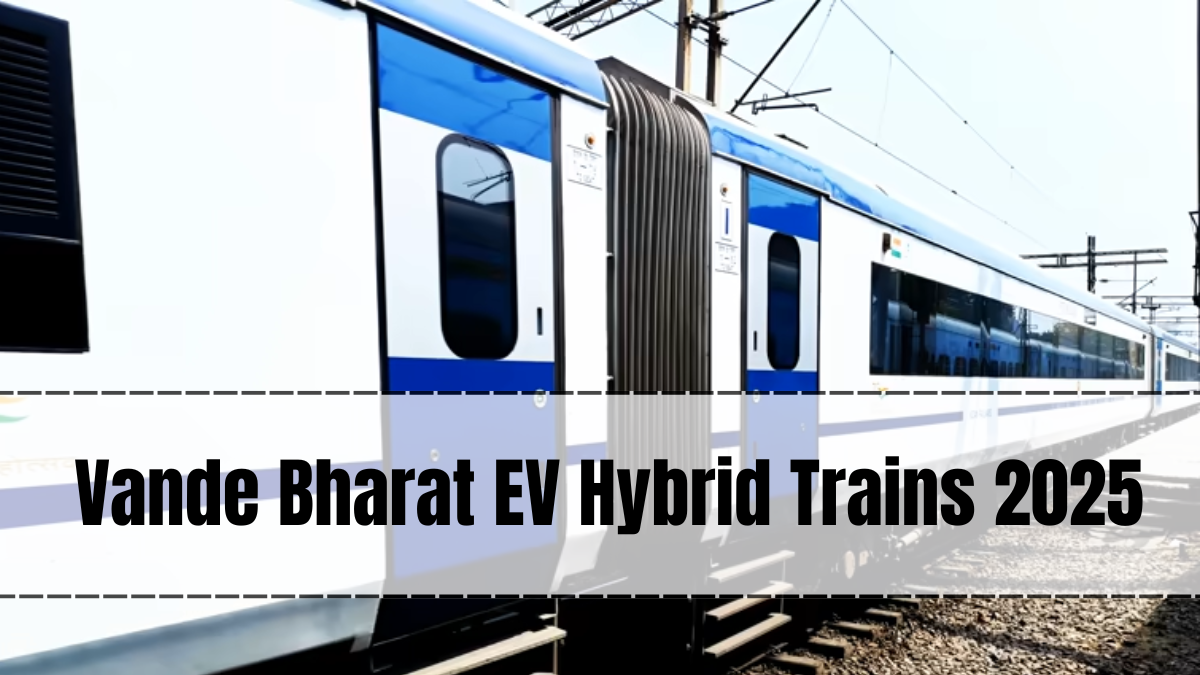In 2025, Indian Railways has taken another big leap toward sustainable transport with the launch of Vande Bharat EV Hybrid Trains. These advanced trains are designed to operate using both traditional electric power and modern battery-based propulsion systems. The dual-power technology reduces carbon emissions, ensures uninterrupted journeys, and sets a benchmark for green mobility in the railway sector.
The Vande Bharat series has already become a symbol of India’s high-speed, modern rail travel. The introduction of hybrid technology now makes it not just faster, but also cleaner and more efficient.

What Makes EV Hybrid Trains Different?
A Vande Bharat EV Hybrid Train combines two power sources:
-
Overhead Electric Lines – For high-speed travel on electrified routes.
-
Battery Power – For operating on non-electrified tracks or in case of power supply disruptions.
This dual capability offers flexibility, making the trains ideal for long-distance routes where electrification is incomplete. It also reduces dependency on diesel locomotives, cutting down fuel costs and harmful emissions.
Key Features of Vande Bharat EV Hybrid Trains 2025
The Vande Bharat EV Hybrid Trains come packed with advanced features:
-
Energy-Efficient Motors – Reduce overall power consumption.
-
Regenerative Braking – Captures and reuses braking energy.
-
High-Capacity Lithium-Ion Batteries – Enable longer battery-only operation.
-
Noise Reduction Systems – Ensure a quieter travel experience.
-
Smart Passenger Amenities – Wi-Fi, infotainment, automatic doors, and better seating comfort.
These upgrades not only improve operational efficiency but also enhance the passenger experience.
Environmental Benefits of Hybrid Technology
The adoption of EV hybrid technology in the Vande Bharat trains is a significant step toward sustainable rail travel. The benefits include:
-
Lower Carbon Emissions – Reduced reliance on diesel cuts greenhouse gas output.
-
Energy Conservation – Efficient battery usage saves electricity.
-
Less Air Pollution – Clean battery power reduces harmful particulates.
-
Quieter Operations – Ideal for city routes where noise pollution is a concern.
This makes the trains an important part of India’s green mobility mission.
Impact on Railway Operations
The hybrid system will revolutionize railways in several ways:
-
Operational Flexibility – Trains can run seamlessly across electrified and non-electrified sections.
-
Reduced Delays – Power supply disruptions won’t cause halts.
-
Cost Efficiency – Savings on diesel fuel and maintenance.
-
Better Rural Connectivity – Hybrid trains can reach remote stations where electrification is still in progress.
By integrating EV hybrid technology, Indian Railways can maintain high service levels even in challenging infrastructure conditions.
Challenges in Implementation
While the Vande Bharat EV Hybrid Trains are a breakthrough, certain challenges remain:
-
High Production Costs – Advanced battery technology and hybrid systems are expensive.
-
Battery Maintenance – Lithium-ion batteries require careful handling and periodic replacement.
-
Infrastructure Adaptation – Charging facilities for trains need to be installed at major stations.
-
Training Requirements – Railway staff must be skilled in operating and maintaining hybrid systems.
The government is addressing these challenges with phased deployment and training programs.
Future of EV Hybrid Trains in India
The Vande Bharat EV Hybrid initiative is only the beginning. Future plans include:
-
Full Electrification Support – More routes with hybrid capabilities.
-
Improved Battery Technology – Longer range and faster charging.
-
International Routes – Possible cross-border train services using hybrid technology.
-
Integration with Renewable Energy – Charging stations powered by solar and wind energy.
As technology evolves, hybrid trains are expected to become even more efficient and affordable.
Final Thoughts
The Vande Bharat EV Hybrid Trains 2025 project represents the future of Indian rail travel — a blend of speed, efficiency, and environmental responsibility. With EV hybrid technology, Indian Railways is ensuring that modern transport solutions also support the planet’s well-being.
This step reinforces India’s commitment to sustainable infrastructure while giving passengers a faster, cleaner, and more comfortable travel option.
FAQs
What is special about the Vande Bharat EV Hybrid Train?
It uses both electric power from overhead lines and battery power, allowing it to run on electrified and non-electrified routes.
How does the hybrid system help in reducing pollution?
By reducing reliance on diesel engines, it lowers carbon emissions and air pollutants.
Can the train run entirely on battery power?
Yes, but only for limited distances depending on battery capacity.
Will passengers notice any difference compared to regular Vande Bharat trains?
Yes, the hybrid trains are quieter, more energy-efficient, and offer uninterrupted journeys even during power supply disruptions.
When will these trains be available across India?
The rollout has started in 2025 on select routes, with wider deployment planned in phases.
Click here to know more.
